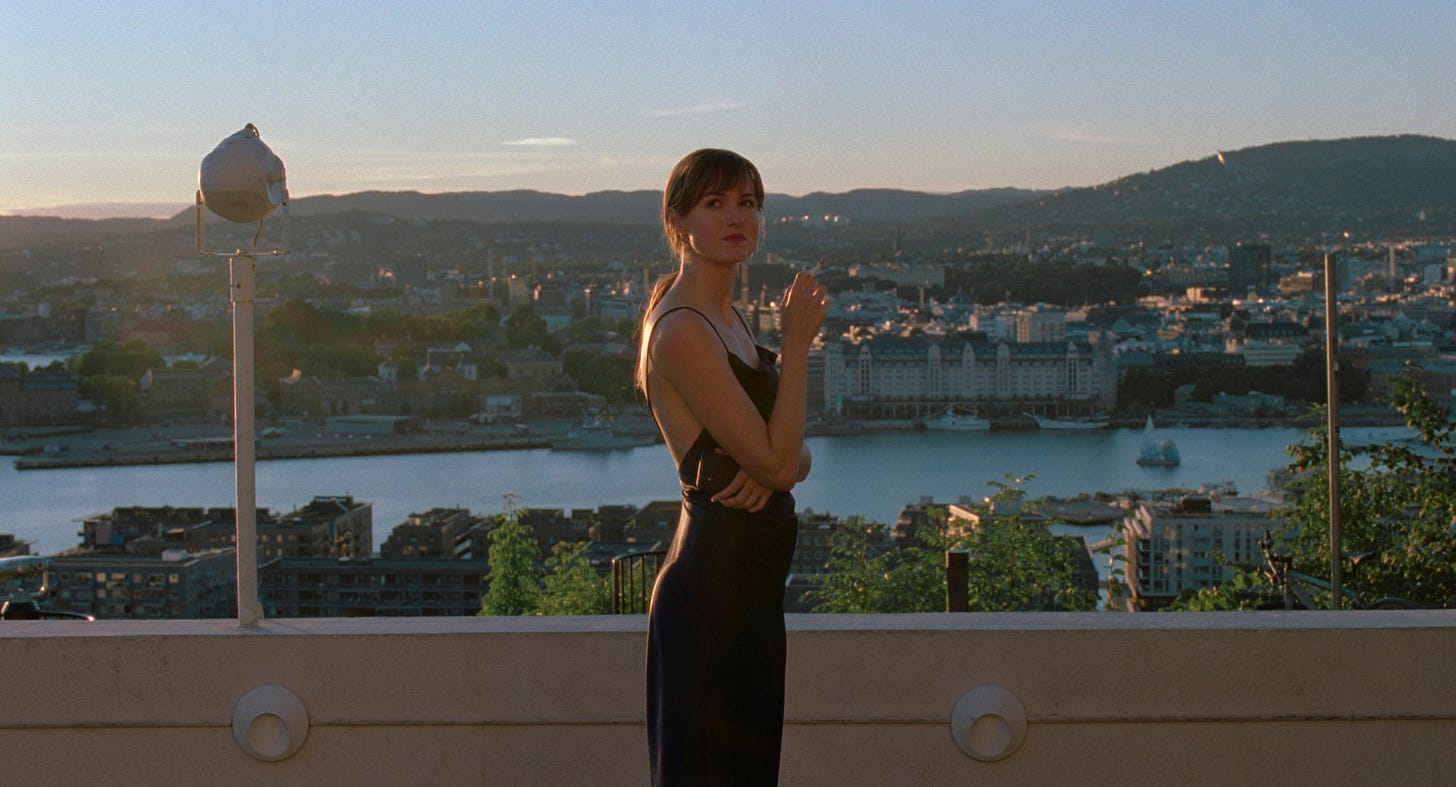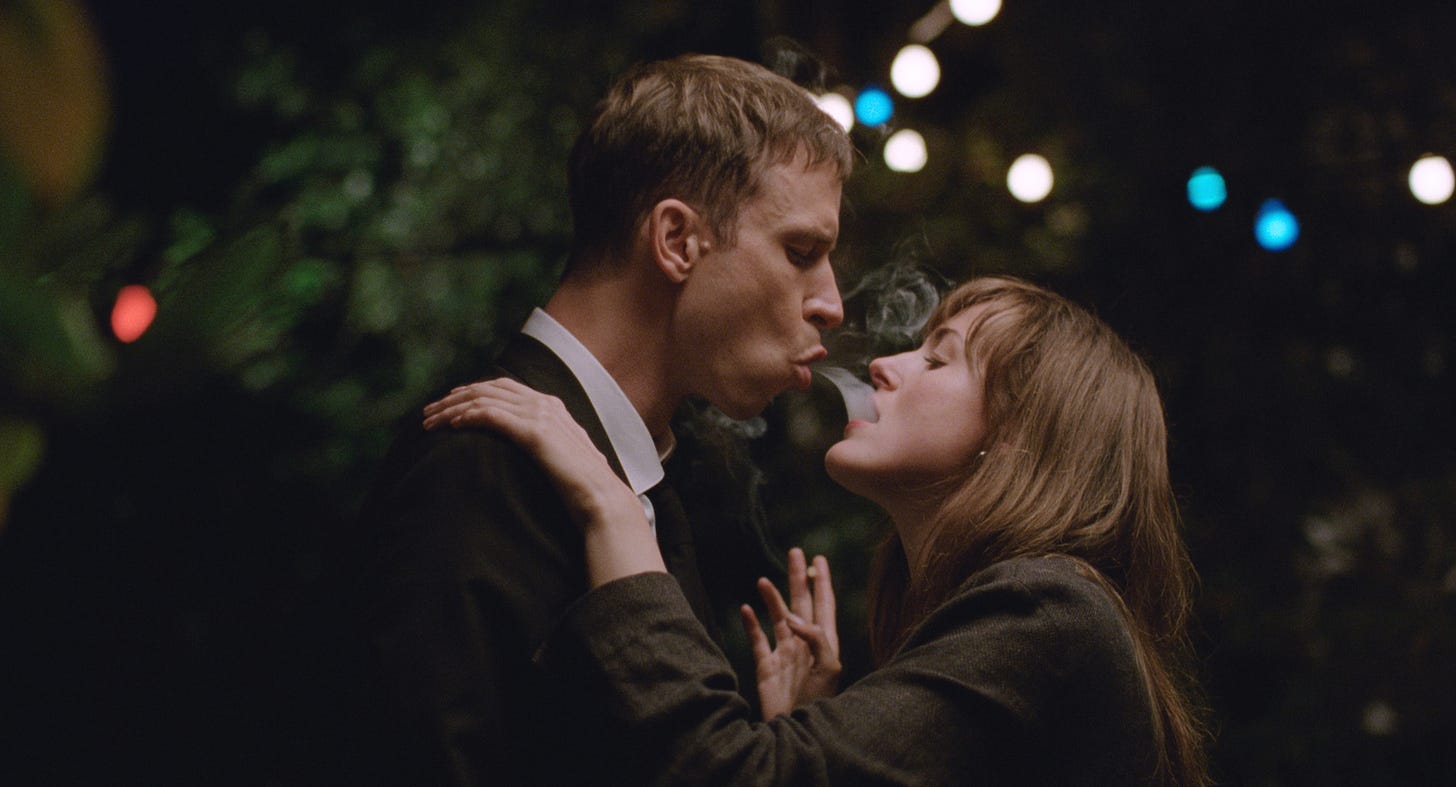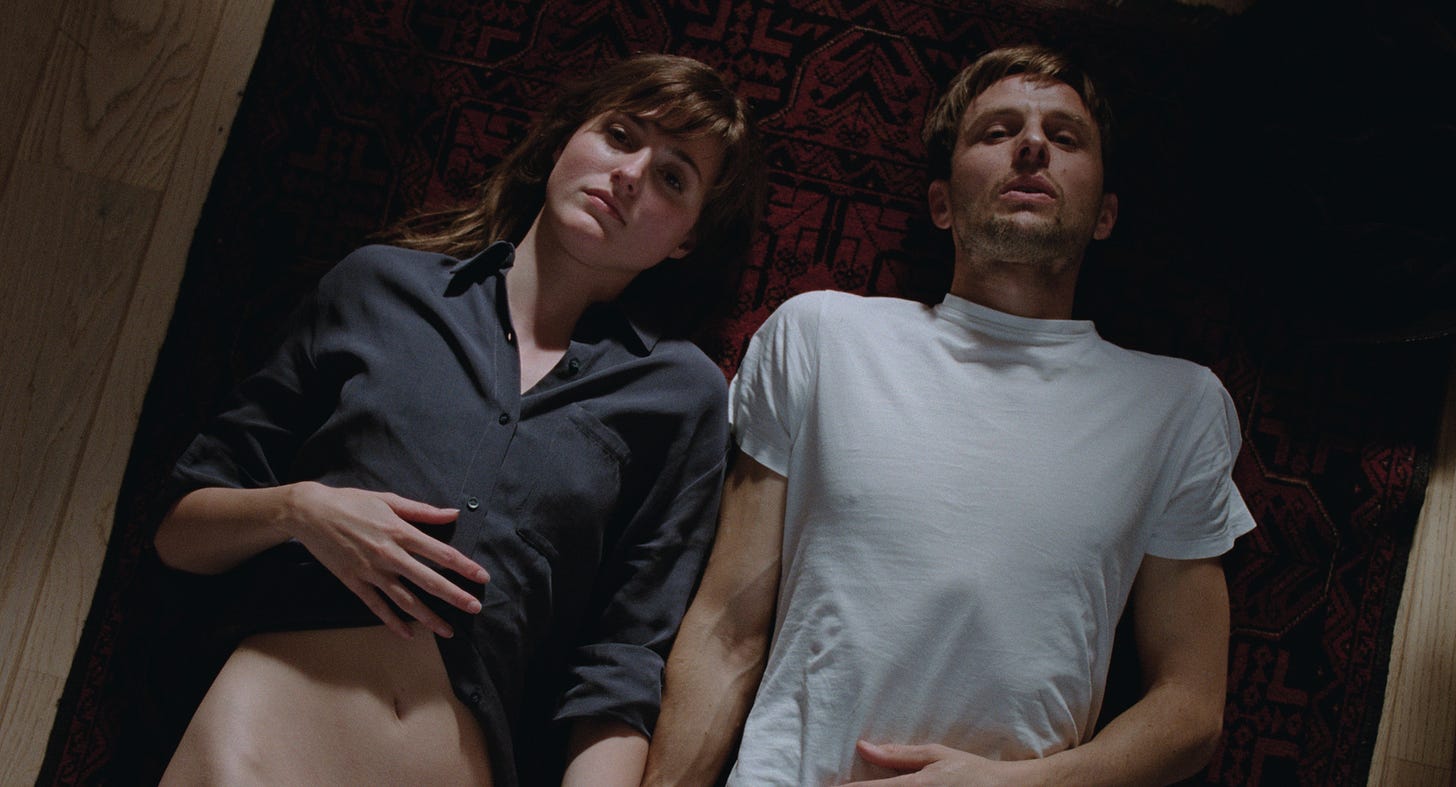An Insider’s Guide to the Oslo of 'The Worst Person in the World'
The Barcode? Video Nova? The Oslo-based editor and film critic Karsten Meinich unlocks some references you might have missed in Joachim Trier's latest
An early scene in The Worst Person in the World finds its heroine Julie (Renate Reinsve) crashing a wedding and ending up in an unexpectedly intimate situation with Eivind (Herbert Nordrum), a handsome guest. As the flirtation intensifies, they start to trade secrets. After Julie volunteers a sexual preference she finds embarrassing (one that will serve as a plot point later in the film), Eivind confesses a truth of his own, replying “I like the Barcode Project.” It’s a reference unlikely to resonate with viewers outside of Norway. What is the Barcode Project, and why is it somewhat embarrassing to like it? The film moves on, and it’s easy to wonder: What else might non-Norwegians be missing?
The Worst Person in the World completes what director Joachim Trier now calls his Oslo Trilogy, a string of films that began with his 2006 debut Reprise and continued with its 2011 follow-up Oslo, August 31st. All are rich with details specific to Oslo life, and, per Karsten Meinich, that sets them apart. “Reprise was the first Norwegian film that was about my life in Oslo.” A film editor and critic, Meinich serves as one of the three editors-in-chief of the Norwegian film publication Montages and, when I put out a call for a guide to the Oslo of The Worst Person in the World, Meinich answered. Via Zoom we discussed the film’s Oslo-centric elements, the video store that helped keep film culture alive in Norway, and why The Worst Person in the World star Anders Danielsen Lie, who plays Aksel in the film, wanted to talk to Meinich about it. But getting to all that meant circling back into Norway’s fascinating history.
The Reveal: Watching this movie I was puzzled by the reference to the Barcode Project. Can you explain that to me?
Meinich: I can try to explain. Today Norway is an embarrassingly rich country, and it's kind of against our nature... well, let’s step a few hundred years back: Norway is not an independent country. It's ruled by either Denmark or Sweden, the big brothers. We got our independence in 1905 and then were invaded by the Nazis while Sweden remained neutral. So Norway go into postwar Europe in a very strange and special position. We were not a rich country yet. We were a mountainous nature country with a couple of tortured existentialist writers and artists–Henrik Ibsen, Edvard Munch–that led our way into some sort of modernism. And there's not much film culture in Norway before the Second World War that's not directly coming off of whatever happened in Denmark or Sweden. So we don't have silent movie masterpieces and such.
And then in the late 60s, we find oil! We became the Saudi Arabia of Northern Europe. But the spirit of Norwegian politics and people is not to spend that money. It's just to sit on it and save it for future generations. As we move into the ’70, ’80s, ’90s, Norway gets gradually richer and richer. And by that point, cities and towns and municipalities realized that we could actually build stuff that we haven't had before. We didn't have a proper opera house like Copenhagen or Sydney or other major cities.
So, Oslo goes from… a village to a city. When I was growing up, it was a couple of hundred thousand inhabitants, and now it's approaching a million. But the building boom within Oslo is limited, because the northern edge of the city borders the wilderness. It was decided many years ago to set up a forest border, which means that no building, no development of new housing, nothing can be built there. The subway goes up to the edge of the forest, a couple hundred meters up into the hills above Oslo. And it stops there. And you can just put on your skis and walk into the forest and there's moose and whatever. But if a city's going to double its size, where is it going to go? Where's it going to grow?
The Reveal is a reader-supported newsletter dedicated to bringing you great essays, reviews and conversation about movies (and a little TV). While both free and paid subscriptions are available, please consider a paid subscription to support our long-term sustainability.
There's this harbor, Bjørvika, just off of the central station. You have this little harbor, that's the end of the fjord coming in, and there you have Oslo. Previously, it was just traffic everywhere. And it was trashy. And the whole harbor, like in many cities, you would just have this industrial dead zone, and industry had fallen apart. So someone said, “this is where we put the opera house. And when we put the opera house there, everything else is going to come.” So all of these plots of land that were owned by the municipality harbor were sold off, and they were the first things to build after the opera house, which is famous now–it was seen as one of the modern architectural wonders of the 2000s.
The first thing they built is a string of buildings called the Barcode, which are not skyscrapers by your standards, but still some of Oslo’s tallest buildings. They’re built like the UPC symbol you scan on the backside of a product. Different sizes of cubes, and kind of modern architecture, but also quite ugly. But in the beginning you never saw the whole project. You saw the first ones being finished, and everyone was like, this is ugly. We just built the opera house, it was so expensive and beautiful. And then the next thing coming up is ugly. So the reputation of Barcode was quite harsh in the beginning, and the prices on all those real estate like offices and apartments or whatever, went up and became the most expensive in the city. And it kind of creates a wall between the sea and Oslo. But now that everything is finished, a filmmaker like Joachim can come there and find the poetry of it.
The Reveal: It’s actually called The Barcode?
Meinich: The whole vision for that area was called Barcode, but each building is called something different. I'm not an expert on architectural history and all the minute details of what was being built when, but looking at how Oslo has been portrayed in Norwegian films since Reprise premiered fifteen years ago, it's been quite evident that putting this new part of the city on the big screen helps to make it come alive to us. Now, seeing The Barcode in movies like The Worst Person in the World, makes it organically interwoven in our accepted view of what Oslo is.
When Eivind makes that comment… He is apparently less educated than Julie, and he has some issues with it. When he tries to give props to her for the essay he found in the trash, he is saying “You have such a good way to formulate your words.” But the word “formulate,” he says it wrong.
The Reveal: I missed that entirely.
Meinich: He says it wrong, and that makes her angry. She realizes he might not be the man… It’s the cumulation of all that stuff that she's been feeling, and he's totally innocent. She's treating him badly, you can say, but it's also very revealing because with how he expresses one single word he reveals that he's not able intellectually to discuss what she's been writing. And she's thrown. It's an insult to her that he even picks up her work and thinks he can compliment her. And by giving that compliment in the wrong way, she rejects him. And making that joke about the Barcode is a way to set him up, like he wants to apologize for working in a place he might fear that she doesn’t think of as quality.
To us, it's such an important part of the richness of Trier’s Oslo portraits. That he's able to effortlessly incorporate all these details within stories without directly commenting on them. They're just there. But in so many of the scenes where he makes use of specific parts of Oslo, it's not an accident, and when you know the city well, that enhances it.
The Reveal: You worked at Video Nova Majorstua, the store Aksel recalls in his monologue, right?
Meinich: I started working there in high school. Before that I started renting VHSs there in the early-to-mid ‘90s. It was part of a chain of video stores in and around Oslo, and that location was the first store, the one in the neighborhood of Majorstua. It was like a half-basement. You step down from the pavement, into a world of cinema. The guy who started it, he got really wealthy from the VHS era because the store had taste–they had a huge collection. My family and I was living five minutes up the street, so I always went there. And as kids, we were only able to rent a few films because it was quite strict with age limits still in the ’90s. And back then, Norway was still a country where a film like The Life Of Brian had been deemed illegal because it was blasphemous. In 1996, David Cronenberg's Crash was censored. It wasn't screened in Oslo, because the cinemas in Oslo were a monopoly way into the 2000s. It was only one chain owned by the city, and the chief programmer who was in charge could make decisions like that. And if you don't have a market for your film in Oslo, you don't have any in the rest of Norway. So, if you wanted to distribute something artistic, and you didn’t get into the Oslo theaters, the critics wouldn’t even review your film.
The Reveal: Were stores like Video Nova a way to circumvent that?
Meinich: Yes, in a way. Video Nova Majorstua became a cultural thing because it was where you could go and actually find movies. It was the source. If you can't find it there, you can't find it anywhere in Norway. They had VHS imports from the UK, like titles from Tartan Video and Artificial Eye. I remember seeing a job opening at Video Nova for, like, the lowest person in the store, the one who carried all the cassette boxes back into the shelves. I was in high school, and I got the job. My application was like, “I'm going to work on a film in the future that's going to be rented here one time. Please let me in.” And they took me. Later, when I’d edited my first feature film, I sent an image of the DVD on the Video Nova shelf to my old boss and said, “Here it is.” Quite a lot of filmmakers actually worked there. A lot of people ended up in the industry producing, directing. Critics, too.
The Reveal: How did Anders Danielsen Lie come to consult you about the store?
Meinich: I didn't know the script, and he had just sent me a message saying, “For the new film, I just need to know what Video Nova Majorstua was like inside.” And I said, “Well, it's a shoe store now.” He replied, “Yeah, but can we meet and walk through the shoe store and you will tell me where everything was?” We tried to arrange something, but they were getting towards the shoot, so I just chatted with him a little bit about it. And then we just left it at that. I didn't know how much of a big deal it was. And it was just for one line in the monologue: “I can close my eyes and see the aisles at Video Nova Majorstua.”
When I heard that, it felt like… That whole monologue about what we are losing, the physical formats and the way we attach ourselves to art and stories and the way that was all being shared physically. Cassettes, recorded stuff from the radio, videos and all that. And connecting that to life and the fragility of our bodies, it was so moving to me when I saw it in Cannes, it really wrecked me. Knowing that reference, and knowing that video stores die, and knowing that if the streaming services own everything and one day shut down–where are the movies going to be? I hope there's some pirates out there who take care of all this for us.
But Anders remembered that store well. And he was a face on the shelves even when I grew up – he had a major role in a Norwegian film when he was a child.
The Reveal: I knew he was a doctor but I didn’t know that.
Meinich: It's called Herman. He plays the title character and it's very famous in Norway, though it hardly traveled anywhere internationally. He played a boy who loses his hair. So that film is referenced in the scene when Aksel sits in the staircase at the end of The Worst Person in the World, and he's lost his hair and wears a cap. It's almost the same scene he played as a child in Herman. And then when he notes that outside the window there used to be an old drunkard here, that is a character from that film. So it's like a layered reference to Anders Danielsen Lie's own role in a movie as a child in a Norwegian film in that part of the city.
The Reveal: What about the other stores he references, Pretty Price and Voices?
Meinich: I know both of them, but they weren’t where I went. I went to other stores. In Oslo there's one physical store for new music and film releases left. Then there are the specialty vinyl stores that have popped up, like Big Dipper, and a used record store called Råkk&Rålls
The Reveal: Before I let you go, as someone who doesn't know Norway or Oslo, what else might we have missed over here?
Meinich: Well, there's this frequent use of parks in Trier’s movies. Oslo is a city where you can walk everywhere, and he often uses the parks in Oslo as sort of transformative locations where characters are talking about or moving through something very important in their lives. Even if you're in a hurry, you can bicycle or walk and mostly get around quite easily. It's very much part of Oslo's identity that we believe our city to be like a small town within a big city. If you are moving through Oslo, you can always move through a park to get to where you're going. His films are always geographically correct. You won't find him cutting from one place to a whole other place.








This is all just completely fascinating! I'm glad I read it before my second watch, some really great, beautiful context. Thanks for tracking down a local!